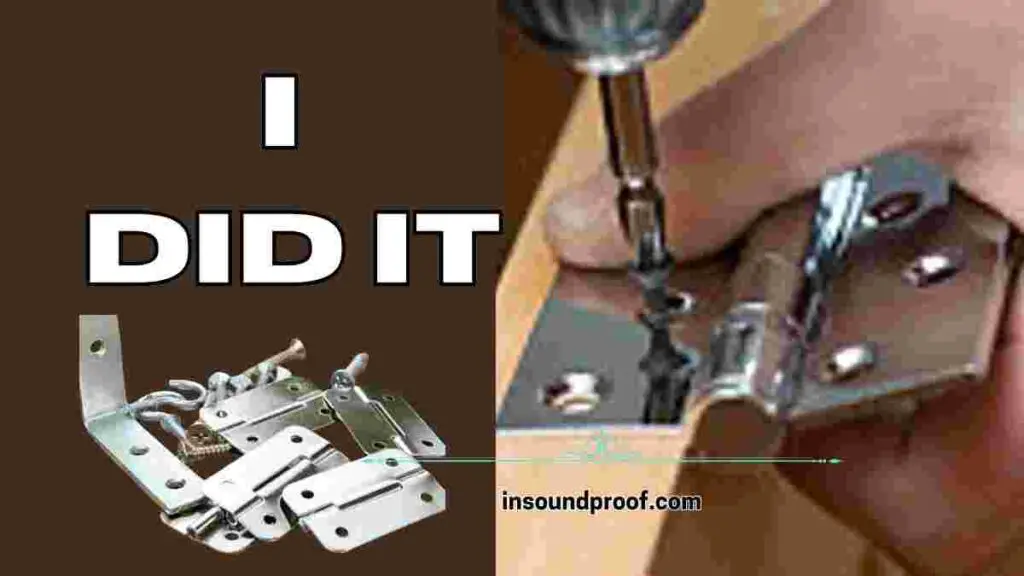As a working professional, you’re no stranger to problem-solving. But what happens when your trusty door hinges start creaking like an old pirate ship?
Fear not! In this guide, we’ll delve into the fascinating world of door hinges, demystify the process, and empower you to become a DIY door-hinge wizard.
Installing new door hinges may seem like a daunting task, especially if you have no prior experience or professional knowledge.
However, with the right guidance and a little bit of patience, you can successfully replace your old hinges and restore the functionality and aesthetics of your doors.

In this section, we will explore the hidden art of door hinge mastery. We will uncover the reasons why changing your hinges is important, the technical aspects of hinges, and the step-by-step process of installing new hinges. By the end of this guide, you will have the confidence and skills to tackle this DIY project like a pro.
Whether you’re looking to upgrade your door hardware, improve security, or simply fix a squeaky hinge, understanding the ins and outs of door hinges is essential.
So, let’s embark on this journey together and unlock the secrets of door hinge mastery. Get ready to transform your doors and elevate your DIY game to new heights.
Installing New Door Hinges Contents
The Why Behind Installing New Door Hinges
Changing door hinges may seem like a trivial task, but it can have a significant impact on the functionality and aesthetics of your doors. So, why bother changing those seemingly innocent hinges? Let’s explore the reasons behind this hinge revelation.
Firstly, installing new door hinges allows you to upgrade your door hardware. Over time, hinges can become worn out, rusty, or loose, compromising the smooth operation of your doors. By replacing them with new hinges, you can ensure that your doors open and close effortlessly, enhancing the overall user experience.
Secondly, changing door hinges can improve the security of your home. Old or damaged hinges may not provide adequate support, making it easier for intruders to force open your doors. Upgrading to sturdy, high-quality hinges can reinforce the security of your doors, providing you with peace of mind.
Additionally, new door hinges can help address common issues such as squeaking or sticking doors. If you’ve ever been annoyed by the sound of a squeaky hinge or struggled to open a sticky door, installing new hinges can solve these problems. Modern hinges are designed to operate quietly and smoothly, ensuring that your doors function seamlessly.
Lastly, changing door hinges allows you to enhance the overall appearance of your doors. Whether you’re renovating your home or simply want to refresh the look of your doors, selecting hinges that complement your decor can make a significant difference. With a wide range of styles, finishes, and designs available, you can find hinges that add a touch of elegance and sophistication to your doors.
Now that we understand the importance of changing door hinges, let’s delve into the technical aspects of hinges in the next section.
The Anatomy of a Hinge: Let’s Get Technical
Now, let’s dissect a hinge like Sherlock Holmes examining a crime scene.
When it comes to installing new door hinges, understanding the anatomy of a hinge is crucial. Let’s dive into the technical details and explore the different components of a hinge.
Firstly, hinge placement is key. Before you start, measure twice to ensure accuracy. Determine the hinge locations on both the door frame and the door itself. While two hinges are standard, heavier doors might require a third hinge, slightly off-center, to provide additional support.
Next, tracing the hinge outline is like performing magic. Place the hinge on the door and jamb, and carefully trace its shape. It’s important to ensure that the depth of the hinge on the jamb matches the thickness of the hinge itself. This ensures a proper fit and smooth operation.
Now comes the mortise mastery. The term “mortise” refers to carving out wood in the jamb to create a space for the hinge to nestle into. To achieve this, use a sharp chisel and apply gentle taps to carve out the mortise. Be cautious not to go too deep, as this can cause the hinge to wobble like a tipsy penguin. Precision is key here!
Understanding the anatomy of a hinge is essential for a successful installation. By following these steps and paying attention to the details, you’ll be well on your way to becoming a hinge hero. In the next section, we’ll explore the exciting world of installing your new hinges.

The DIY Tango: Installing New Door Hinges
Now, the grand reveal!
Hinge Placement Redux: Align your hinges precisely. Remember the 7-inch-from-the-top and 11-inch-from-the-bottom rule. If you have a third hinge, it’s the Goldilocks Center. This ensures that the weight of the door is evenly distributed and prevents sagging over time. By following this rule, you’ll achieve a balanced and secure installation.
Score and Cut: Score the traced outline with a utility knife. Then, channel your inner Michelangelo and chisel out the mortise. Precision matters! Use a mortise tool for door hinges to ensure a clean and accurate cut. Take your time and make sure the mortise is deep enough to accommodate the hinge, but not too deep to compromise the stability of the door. A well-carved mortise allows the hinge to sit flush with the surface, creating a seamless and professional look.
Screw It: Attach the new hinge using screws. Make sure to use screws that are long enough to securely fasten the hinge to the door and jamb. Start by screwing in the top and bottom screws, and then add the middle screw if you have a third hinge. Tighten the screws firmly, but be careful not to overtighten and strip the holes. Once the hinges are attached, connect the door to the jamb, ensuring the knuckles of both hinges dance harmoniously. Give the door a gentle swing to test its smooth operation.
By following these steps, you’ll be able to confidently install your new door hinges like a pro. In the next section, we’ll put your installation skills to the test and ensure that your door swings flawlessly.
The Final Test: Swing, Swing, Baby!
Now that you have successfully installed your new door hinges, it’s time for the final test: swinging the door open and closed. This is where you get to see the fruits of your labor and appreciate the smooth operation of your newly installed hinges.
Gently swing the door open and observe how it moves. With properly installed hinges, you should experience a seamless and effortless swing. The door should open and close without any resistance or sticking points. This is a sign that your hinges are aligned correctly and the door is properly balanced.
As you swing the door, pay attention to any unusual sounds or squeaks. If you hear any noise, it could be an indication that the hinges need further adjustment or lubrication. Applying a small amount of lubricant to the hinge knuckles can help eliminate any friction and ensure a quiet operation.
Take a moment to appreciate the improved functionality and aesthetics of your door. Your efforts in installing new hinges have not only enhanced the overall appearance of the door but also improved its functionality and durability. You can now enjoy a door that opens and closes smoothly, providing you with privacy, security, and weather resilience.
With the final test complete, you can confidently say that you have successfully installed new door hinges like a pro. Your door is now reborn, and you can take pride in your newfound hinge prowess. Well done!
FAQs About Installing New Door Hinges
Q: Why should I bother changing my door hinges?
A: Excellent question! Changing hinges isn’t just about aesthetics; it’s about safety, weather resilience, and privacy. Faulty hinges compromise security, exterior hinges battle the elements, and interior hinges ensure privacy during important moments (like Zoom meetings).
Q: How do I know where to place the hinges?
A: Precise placement matters! Measure twice, and cut once. Standard practice: two hinges for most doors, but heavy doors might need a third hinge (slightly off-center). Remember the 7-inch-from-the-top and 11-inch-from-the-bottom rule.
Q: What’s this “mortise” thing?
A: Ah, the mortise! It’s like carving out a cozy nest in the door jamb for your hinge. Use a sharp chisel and gentle taps. Too deep, and your hinge wobbles like a tipsy penguin.
Q: How do I install the new hinges?
A: The DIY tango! Align hinges precisely, score the traced outline, channel your inner Michelangelo to chisel out the mortise, and screw in the new hinge. Voilà!
Q: Is my door reborn now?
A: Indeed! Swing it open, close it gently, and marvel at your newfound hinge prowess. You’re a hinge hero!
Q: Can I install new door hinges myself?
A: Absolutely! Installing new door hinges is a DIY project that you can tackle with confidence. With the right tools and a little patience, you can achieve professional-looking results.
Q: What tools do I need to install new door hinges?
A: To install new door hinges, you will need a few basic tools, including a screwdriver, a chisel, a hammer, and a tape measure. Additionally, if you are replacing the hinges on an existing door, you may also need a drill to remove the old screws.
Q: How long does it take to install new door hinges?
A: The time it takes to install new door hinges will vary depending on your level of experience and the complexity of the project. On average, it can take anywhere from 30 minutes to an hour to install new door hinges.
Q: Can I soundproof my door by changing the hinges?
A: While changing the hinges alone may not provide significant soundproofing benefits, it can contribute to reducing noise transmission. To achieve better soundproofing, consider using weatherstripping, adding a door sweep, or installing a solid-core door.
Q: Are there any safety precautions I should take when installing new door hinges?
A: When installing new door hinges, it’s important to prioritize safety. Make sure to wear protective eyewear and gloves, and use caution when handling sharp tools. If you are unsure about any step of the process, consult a professional for guidance.
Conclusion: From Novice to Hinge Hero
With your newfound knowledge and skills in installing new door hinges, you have transformed from a novice to a hinge hero. By taking the time to understand the importance of changing hinges, the precise placement, and the process of installing them, you have not only improved the aesthetics of your doors but also enhanced safety, weather resilience, and privacy.
By replacing faulty hinges, you have safeguarded your home and protected cherished memories. No longer will you have to worry about compromised security or exterior hinges battling the elements. With properly installed interior hinges, you can now enjoy important moments, such as Zoom meetings, in complete privacy.
Remember, the key to a successful hinge installation is precision. Measure twice, cut once, and follow the standard practice of using two hinges for most doors. For heavier doors, consider adding a third hinge slightly off-center. And don’t forget the mortise! Carve out a cozy nest in the door jamb for your hinge, ensuring a stable and secure fit.
Now, when you hear that familiar creak, instead of feeling frustrated, you can channel your inner DIY maestro and confidently tackle the task at hand. With your trusty tools and newfound knowledge, you can conquer those hinges like a pro.
So, go ahead and swing open your newly transformed doors. Close them gently and marvel at your hinge prowess. You have become a hinge hero, and even Sherlock would applaud your door-hinge transformation.


